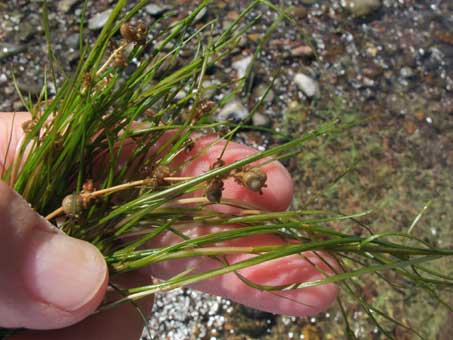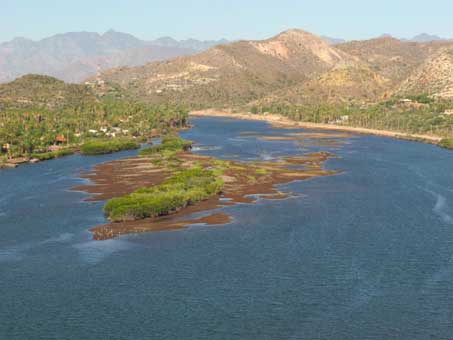This section contains entries about our botanizing in Baja California written for the UC BEE (Oct 2012 to Aug 2021)
and The UC Bee Hive (2022-), monthly newsletters for volunteers and staff of the UC Berkeley Botanical Garden.
Click on any photo for a larger image.
BEE JUNE 2015
Up, Down and All Around Mulegé
I regret not having been able to get out into the field as much as I would have liked this season, but in my last few weeks here, I have tried to cram in as much botanizing as possible, especially with the arrival of warmer weather and lots of flowering activity.
April 2015
Earlier in the week, I had came across a Palo Verde in glorious bloom that immediately caught my attention as something "not belonging" to the usual set of floral flash cards stored in my brain. I immediately perked up as we drove by where it practically hung over the highway from a steep road cut. It took me several days to return and then I had to figure out how to get samples since I didn´t dare climb up the slope, lest I fall down and roll out onto the highway. Walking sticks are marvelous and I was lucky to be able to use mine to snag a branch and carefully pull it down for long enough to collect sufficient sample material.
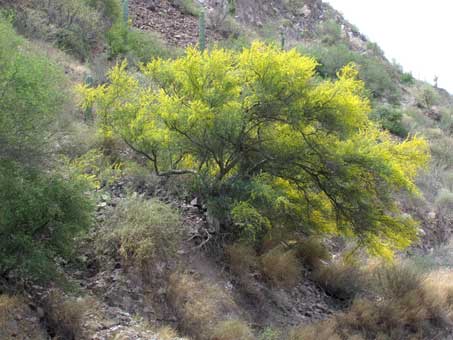
A new species for my inventory: Parkinsonia florida (Palo Verde).
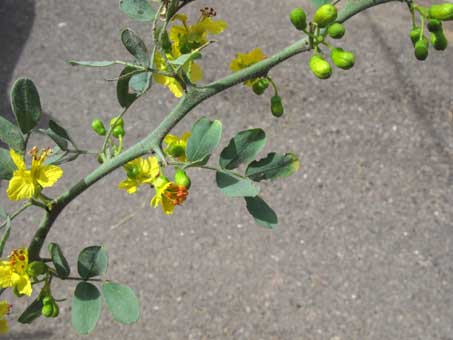
Flowers & large bipinnate leaves of Parkinsonia florida (Fabaceae).
What was so ironic in finding this tree is that I have passed it by hundreds of times over the years at 40 mph without ever noticing its existence, probably because it sits above ones sightline while driving. That I saw it at all this season was only because I happened to be in the passenger seat just at the right time of day and year when the sun was lighting up its gloriously bright yellow crown of flowers and dark foliage.
It was the greenness of the tree combined with the yellow flowers that really caught my attention. It was in full bloom and also sported a dense set of leaves that are much larger and darker green than our common Palo Verde or Dipúa (Parkinsonia microphylla). That species rarely seems to have any leaves when in bloom and appears more monotone because the tree bark is a pale yellow-green, beneath the yellow crown of flowers.
Driving home from my botanizing activities after collecting the Parkinsonia florida, I had to take a new detour that had been bulldozed up and over a steep hill and along the bottom of a narrow canyon in order to bypass construction along one portion of the river road. As I was winding down and enjoying the scenery, I suddenly found myself stepping on the brakes, almost unconsciously, as my mind kicked in once again and registered a plant that wasn't in the data banks.
I pulled over and walked back to a tree that again didn't fit the typical Palo Verde profile for our area. I quickly recognized that it was not a species I'd seen before nor was it P. florida. It had bipinnate leaves with leaflets about 4-6 mm L and all the herbage was densely puberulent (a dense covering of tiny hairs). The fact that it had leaves at all while blooming profusely was–again–what had caught my attention.
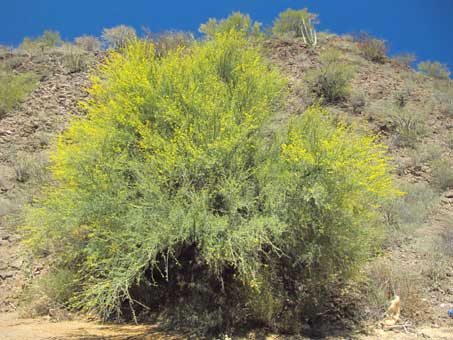
And another new taxon for the list: the naturally occuring hybrid Parkinsonia x sonorae, here a tree 4-5 m tall.
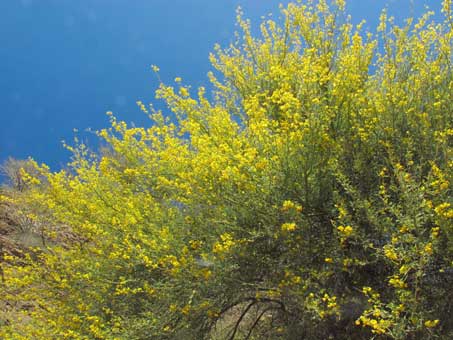
Parkinsonia x sonorae is found where where the ranges of P. microphylla and P. praecox overlap. Note the green leaves beneath.
It turns out that this new taxon is a naturally occuring hybrid of Parkinsonia microphylla and P. praecox and is somewhat common on the peninsula where the ranges of the two species overlap. I have yet to find a P. praecox in our area, but it is likely that there could be specimens at slightly higher altitudes in the mountains in the immediate area above the town or farther up the canyon in the Sierra Azteca to the north (which reach a few hundred meters in altitude).
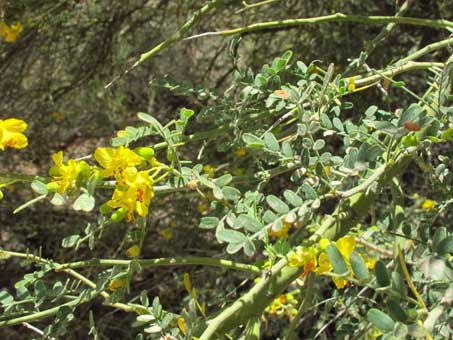
Leaves and branches of the natural hybrid Parkinsonia x sonorae. Compare with those of P. microphylla which are mainly absent by the time of flowering. Leaflets here 5-8 mm L. The tree is unarmed but has some spinose branchlets like in P. microphylla.
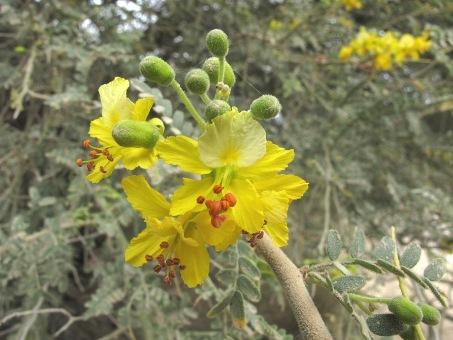
Flowers of Parkinsonia x sonorae. Compare with those of P. microphylla where the banner petal is mostly white until pollinated, while in this species it appears to be only slightly paler yellow. The herbage is puberulent.
The hunt was now on for more specimens of the two new Parkinsonia species. A few days later from the top peak of the detour, I noted that there were some questionable looking trees on a hillside in the distance and there appeared to be somewhat of a trail up to them. So I enlisted my friend Raffita again to do a little investigative work with me (last year he climbed a rocky outcrop to obtain some specimens of a wild fig tree for my inventory project) . The hike was short to the top of the low saddle to where I´d seen the pair of very green and yellow blooming Palo Verdes.
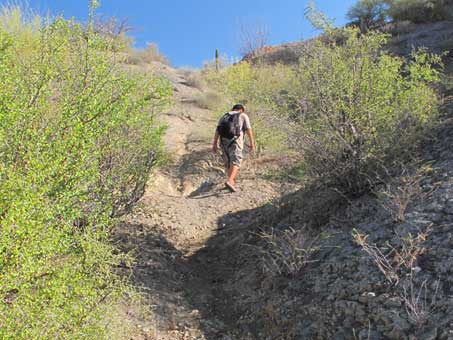
Trail leading up to the saddle where the trees were located.
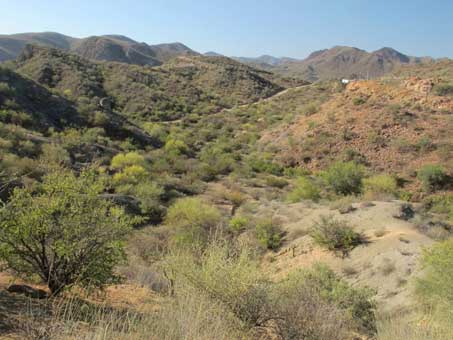
View southward from the saddle, towards the river and town.
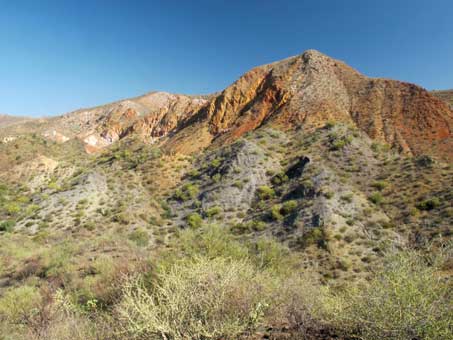
View northward from the saddle towards Cerro Rojo (Red hill).
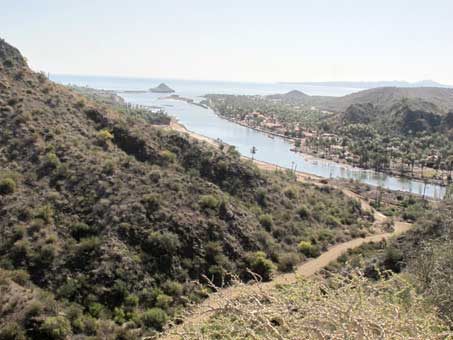
From the top of a different hill nearby, looking down towards the mouth of the Mulegé river.
The view was spectacular from the top of the saddle but unfortunately the trees were just two Parkinsonia microphylla. However, the reason they were so bright green was evident up close: in addition to some flowers, the trees were dense with not quite open flower buds that, from a distance, and with the sun from the southwest, made the trees appear darker than usual.
Historical note: The genus Parkinsonia is named after the 16th Century herbalist and botanist John Parkinson. There's a little bio about him at this link.
Spring is here – April 12-15, 2015
This is the time of the year when many of the Fall-Winter blooming plants are drying up and going dormant. However, the Palo Verde are just getting started with the warmer Spring weather, usually beginning around this time in April in our area. The blooming occurs like a wave that moves from south to north, and from the coast up into the hills.
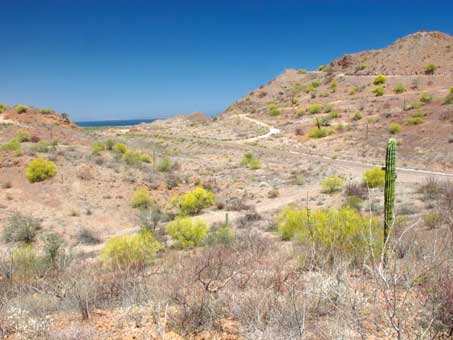
Dipúa or Palo Verde (Parkinsonia microphylla, Fabaceae) in bloom.
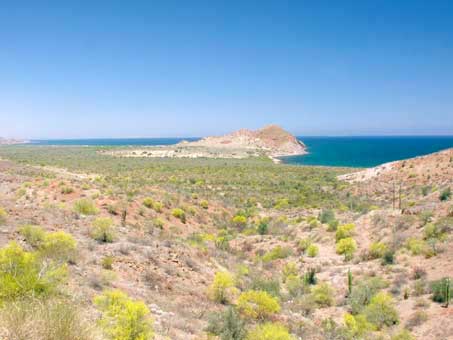
Dipúa or Palo Verde (Parkinsonia microphylla, Fabaceae) in bloom on the rocky hillsides of Tiburón Grade.
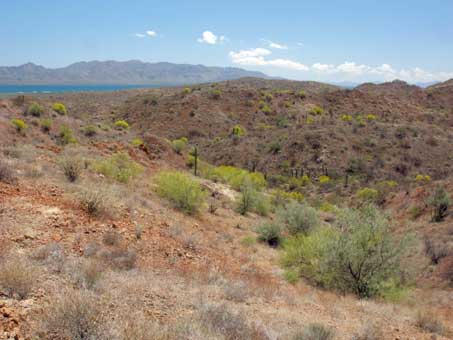
Dipúa or Palo Verde (Parkinsonia microphylla, Fabaceae) in bloom.
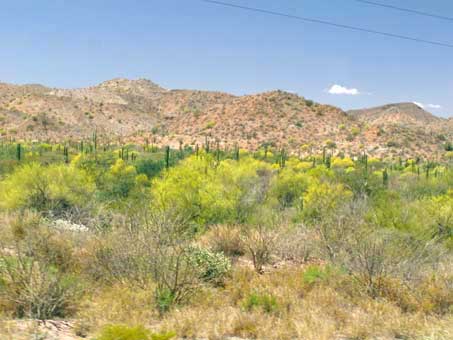
The Dipúa or Palo Verde (Parkinsonia microphylla, Fabaceae) on the bajadas were also blooming madly.
San José de Magdalena – April 12
This season, we were fortunate enough to make several trips to San José de Magdalena, located about 45 minutes northwest from Mulegé by paved road. Our last trip was the week before we left and the weather was wonderfully warm that day and the water very inviting. Spring was beginning in the mountains in the valley and the hillsides. See this entry for more about the small town, known locally for its garlic crop.
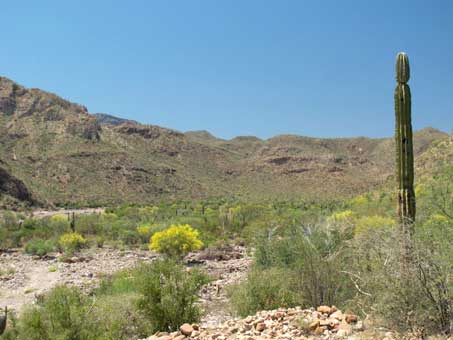
Parkinsonia starting to bloom near the arroyo. P. microphylla was in the lead, with a few P. florida as well. Both are common here where the altitude is slightly higher than in Mulegé.
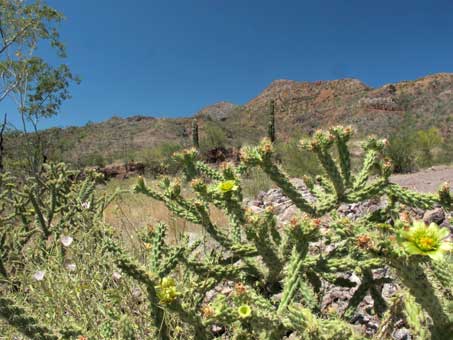
The peninsular endemic Cholla barbona (Cylindropuntia alcahes var. alcahes).
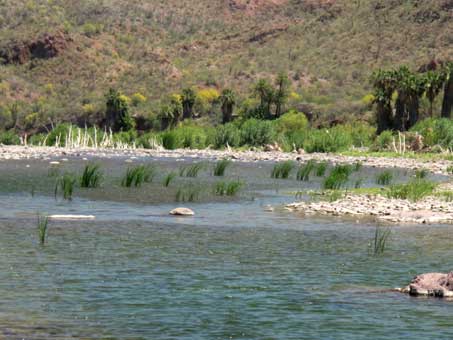
The arroyo bed was changed a great deal by the high volume of water flowing out of the mountains to the west during the passage of tropical storm Odile in September 2014. Lots of water remained.
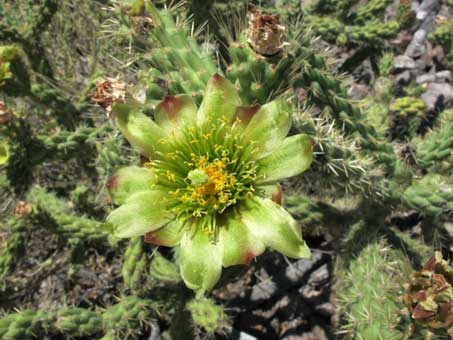
Flowers of Cholla barbona. In our area, they tend to be yellowish green with a hint of red. In other areas, they can be much redder.
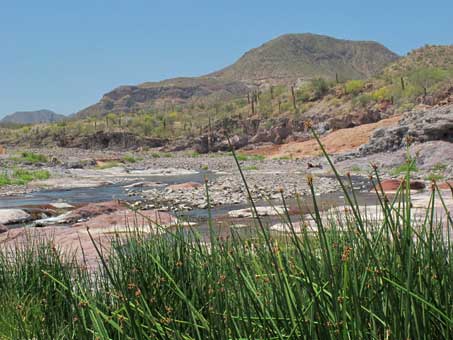
Lovely pools in the slick rock, known as tinajas. Junco / Bulrush in foreground (Schoenoplectus americanus, Cyperaceae).
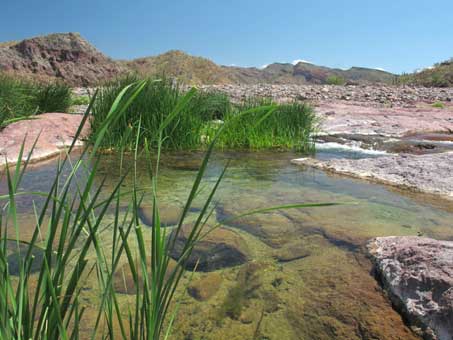
This shallow pool at the edge of the flowing stream was very clear and inviting. Cattails in foreground, Bulrush and cattails behind.
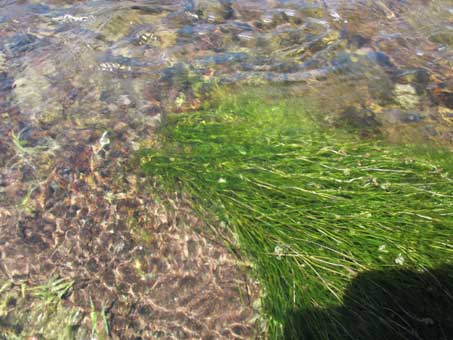
Finally, a new species for me: Sago pondweed / Granza. (Stuckenia pectinata, Potamogetonaceae). Rooted in the mud, it was floating at the surface.
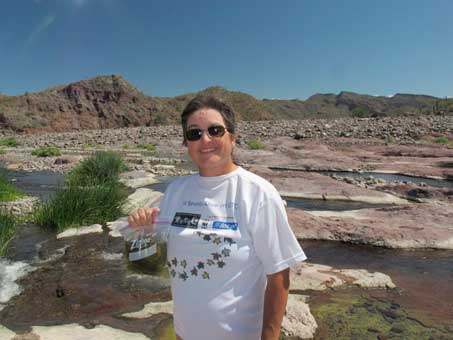
I am always happy to collect a new (to me) species, here with a baggie of Sago pondweed.
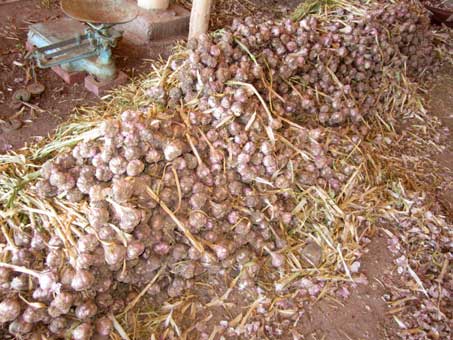
Garlic bulbs waiting to be braided then shipped to market.
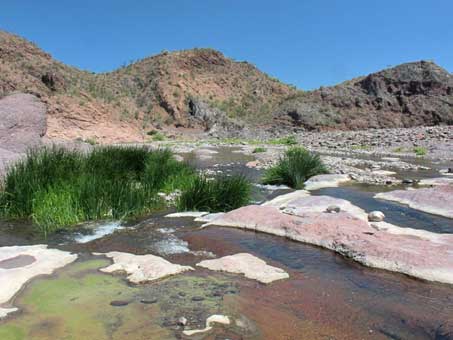
The water temperature was perfect for a dip. Besides the Bulrush, there were young cattail plants (Typha dominguensis, Typhaceae).
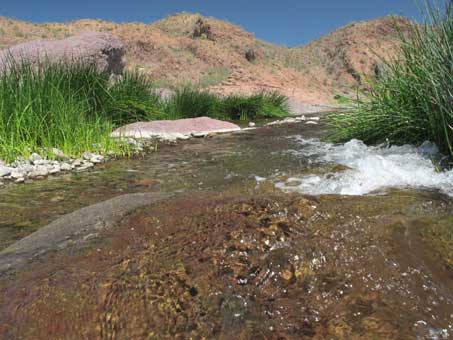
The volume of water is surprising for the location which is surrounded by an arid desert.
Sago pondweed is a monocot with grass-like culms & leaves. The plant was about 1.5 m long. Here with inflorescences.
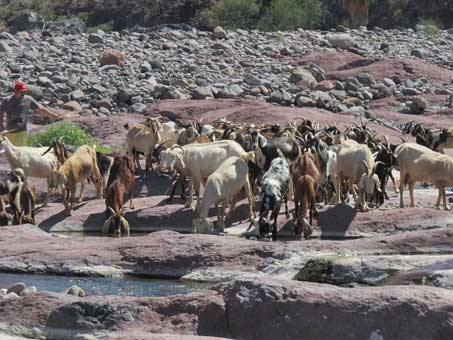
This herd of goats and the goatherd went leaping across the pools as we were preparing to leave.
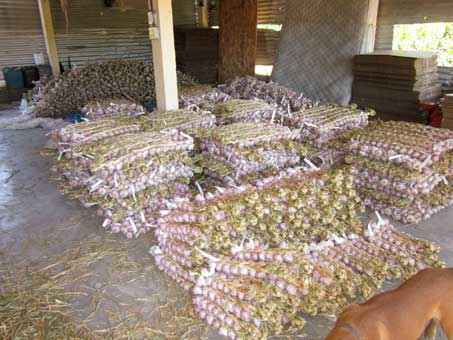
Garlic braids stacked and ready for loading into the truck.
El Faro (Mulegé Lighthouse) and Estuary – April 22, 2015
One of the results of the September flood was that the spit between the lighthouse and the north shore of the river was breached and had still not closed on its own after 7 months. The only way was to wade over at low tide, but I hadn't felt up to doing that. The access road was finally "repaired" about a week before we left for the north and I was feeling the pressure to hike over to it before we left for the north and lost my opportunity for my annual photo op from the top of the hill.
On our last full day in Mulegé, I finally hobbled the 50 meters from our place to the beach and limped up to the base of the lighthouse to take photos of the river mouth and the ever-shrinking patches of mangrove.
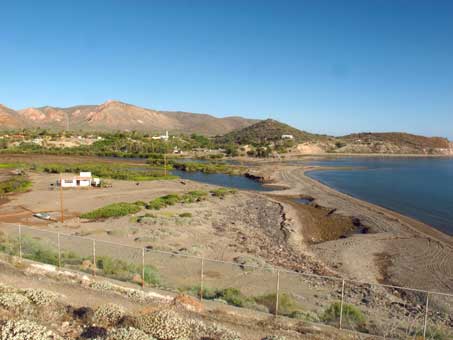
Damage to the spit is still visible. Little sand remains; it's mostly gravel and small rocks and the repaired access point is again underwater at high tide. Looking northward.
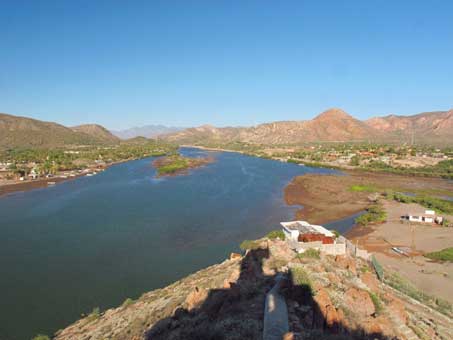
View of the estuary (westward). Very little mangrove cover remains. See comparison of past images. Lots of rocks and sediment were carried towards the mouth (bottom, right).
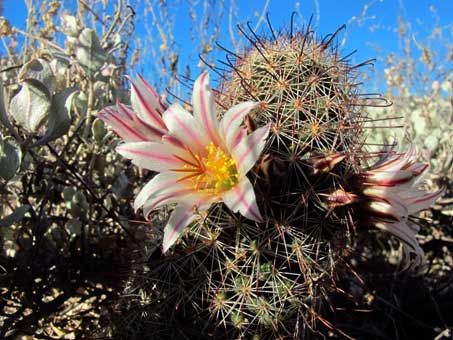
A new species, most likely Mammillaria hutchisoniana for my inventory (tentative det. Jon Rebman, SDNHM).
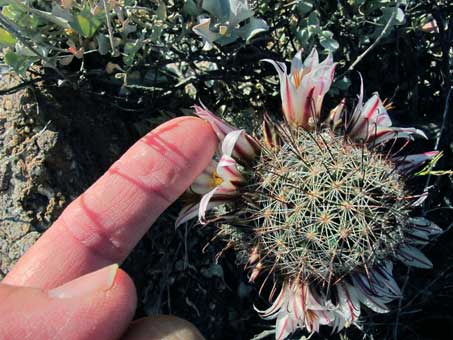
Compared to the ubiquitous Mammillaria dioica, the flowers of this species are huge, the stigmas reddish brown, and it lacks axillary bristles (at base of tubercles).
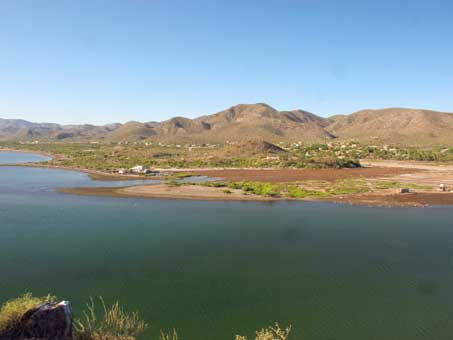
View southward, towards Bahía Concepción. The innundated part of the saltflat just past the edge of the shoreline expanded with the latest flood.
Gravel/sandbar that used to be the home of a dense mangrove forest. The area is highly fragmented and at high risk of disappearing very soon with more flooding.
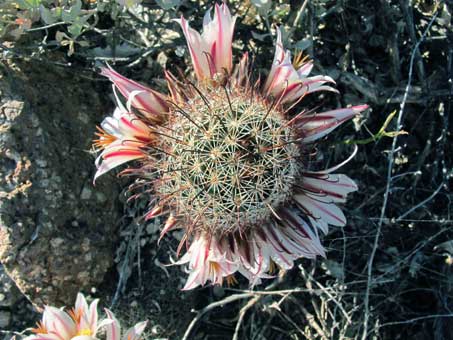
The large, showy flowers on this diminutive cactus caught my attention as I was headed back down the hill.
The Ojo (Headwaters) and Palm Oasis
I had to make one last visit to the Ojo the day before we left. I had the opportunity to take a friend of a friend on a short, guided tour of the area. I was surprised at how much the ground water had seeped up above the surface in the razed area of the "diversion canal" dug last Spring and then re-done this past winter, creating a new wetlands area. There were lots of reeds (Cyperus elegans, C. umbellatus and Schoenoplectus americanus, Cyperaceae) and Cattails (Typha dominguensis, Typhaceae) taking root, as well as the pesky Carrizo or Giant Reed (Arundo donax, Poaceae). I also saw a lot of Bacopa monnieri and Stemodia durantifolia (Plantaginaceae) growing close to the water's edge. There were also many lovely bird songs and the buzzing of bees & wasps on our later afternoon walk.
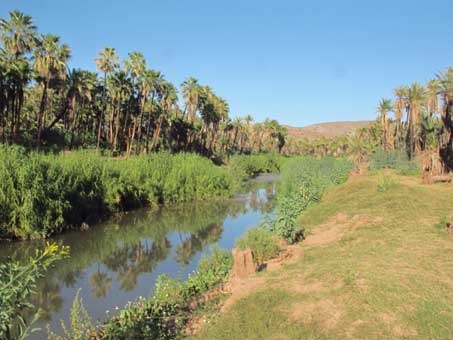
The edge of the river was cleared out by a brush fire in May 2014 and then the flood later that year in Sept. Giant Reed (Arundo donax) is making a strong comeback on the banks.
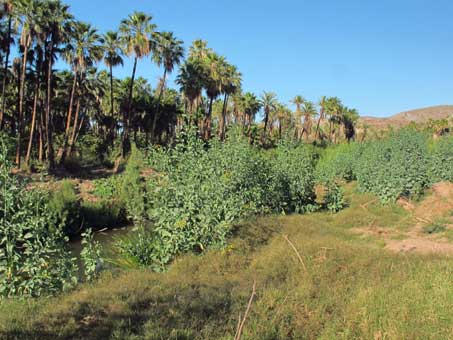
This part of the river was untouched by the diversion project. However a fire in May and the cleanup afterwards left the banks bare. Plants are quickly recolonizing the banks. See photo of nearby area from 2013.
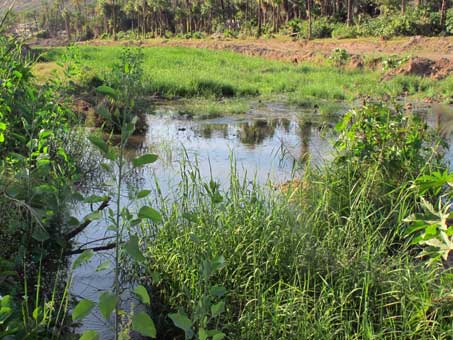
The diversion canal they dug at the Ojo has resulted in more ground water at the surface and the plants have multiplied quickly.
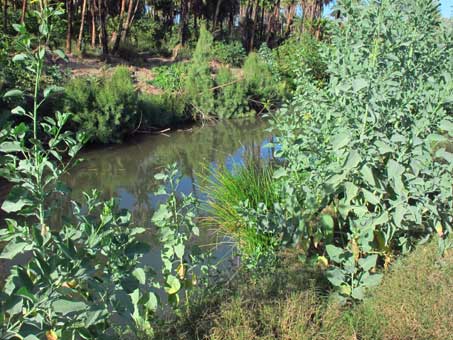
The weedy Tree Tobacco (Nicotiana glauca, Solanaceae) is coming back strong just above the edge. The Bulrush (Schoenoplectus americanus) survived the disasters intact.
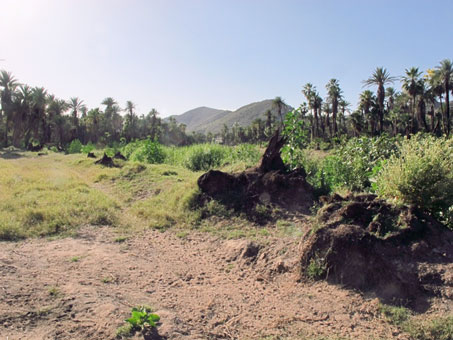
Looking west towards the Ojo along the new diversion canal that was created by razing a large part of the historical palm orchard. A large number of palms were lost to the fire as well.
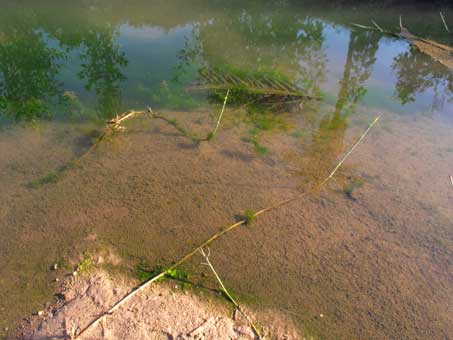
Runners of Carrizo / Giant Reed (Arundo donax, Poaceae) 3-4 m L heading from shore into the river to recolonize the banks.
Next month, I'll share some images and notes from the northern state as we headed home to California Alta. Until then, hasta pronto...
Debra Valov—Curatorial volunteer



























